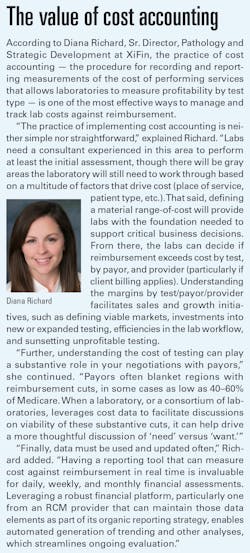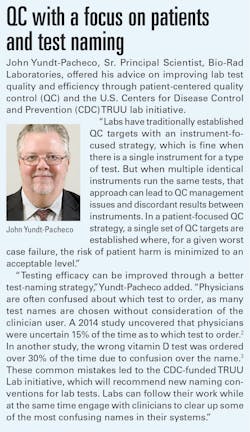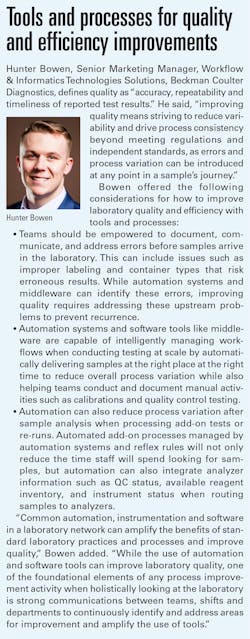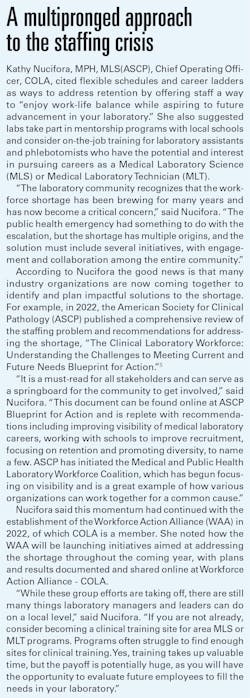We gathered responses from 255 clinical laboratory professionals with 63% of respondents in director, manager, administrator, or supervisor positions, and most employed by hospitals (66%).
The survey results provide insights into best practices around controlling costs, optimizing contracts, capturing reimbursements, managing supplies, implementing technology solutions, navigating staffing shortages, and improving the quality and efficiency of testing.
Alongside the quantitative data, the article presents write-in comments from lab professionals who took part in the survey, along with commentary from COLA Chief Operating Officer Kathy Nucifora, MPH, MLS (ASCP), and clinical lab service and solutions providers.
Payments for lab services from the Centers for Medicare & Medicaid Services and other payers have been cut in recent years as labs face the challenge of increased supply and labor costs.1
When asked what steps they had taken to ensure reimbursements cover their costs, over half of survey respondents said they had created standard lab processes and staff education materials (53%) or standardized instrumentation workflows and checklists (52%).
Next highest on the list was incorporation of IT solutions to reduce human error (40%), followed closely by the adoption of analyzers that provide walkaway testing to reduce staffing and FTE hours (39%), and adoption of processes to review savings opportunities, such as evaluating analyzers, on a regular schedule (38%).
Nearly one-quarter of lab professionals surveyed said they have incorporated IT solutions to help keep current with regulations (24%), followed by those who had implemented ongoing waste and efficiency studies to find potential savings in overhead (19%), or implemented ongoing efforts to reduce coding frustrations and modifications (18%).
For those respondents who said their labs cannot track whether reimbursement covers their costs, the top challenges holding them back were not having the software to automate tracking/analysis of costs (35%), followed closely by lack of interoperability between laboratory information system (LIS) and revenue cycle management software (34%), and not enough staff time (32%). Much lower on the list was not enough barcoded testing supplies (7%) and point-of-care testing (POCT) products (6%).
Controlling contracts and costsLooking at steps to improve inventory control and consumable supply costs, top on the list was the evaluation of inventory levels for basic supplies, such as assays and controls/reagents, with nearly three-quarters of respondents having taken this step (74%). Second highest on the list was the development of supply utilization tracking and record keeping (40%).
Only 20% of those surveyed indicated they had worked with other members of the organization, such as the chief medical officer (CMO) and physicians, to standardize test ordering throughout the organization, which was down from 36% in 2022. The same percentage of respondents (20%) said they had developed an ongoing review comparing supply reports to the number of invoiced tests, which was up from 15% last year.
A greater percentage of respondents in 2023 had secured access to electronic inventory tracking from the supply chain/materials management department (from 13% in 2022 to 18% in 2023) or implemented lease agreements that do not include volume commitments (from 10% in 2022 to 18% in 2023). Fewer respondents selected vendor-managed ordering as a step to improve inventory control and consumable supply costs (from 19% in 2022 to 15% in 2023).
Among the write-in comments for this question, one lab professional said they had assigned specific technicians to departments to “keep up with expirations dates and usage.” Another wrote they had employed their own supply technician. A third said they had utilized test volume tracking on instruments to allow “just in time” loading of required supplies to reduce waste and get the most use out of reagents.
With regards to best practices for streamlining the contracting process, 65% of individuals surveyed said they worked with supply chain management on supplies that are on group purchasing organization (GPO) contracts that offer additional savings, and nearly half (48%) had developed good relationships with supplier support personnel to secure access to training and product optimization suggestions. Next on the list of best practices was ongoing reviews of reference lab costs and contracts (40%), followed by signing longer contracts (20%).
Regarding steps taken to improve the quality and efficiency of testing in their labs, the majority of those surveyed had standardized test ordering procedures and formularies (63%), followed by evaluation of temperature monitoring equipment and procedures (51%).
Over one-quarter of respondents (27%) indicated they had implemented evidence-based test utilization backed by data, with the implementation of evidence-based test utilization backed by data last on the list (22%).
Addressing staffing shortages
According to the U.S. Bureau of Labor Statistics, about 25,600 openings for clinical laboratory technologists and technicians are projected each year, on average, through 2031, with many of those openings “expected to result from the need to replace workers who transfer to different occupations or exit the labor force, such as to retire.”4
MLO asked survey respondents if they had implemented measures to retain and recruit staff. More than half (53%) said they had offered financial incentives (sign-on bonuses, merit allowances, retention bonuses), and 50% had provided continuing education.
Shift changes to offer employee scheduling flexibility (12-hour shifts, weekends, etc.) was another popular choice (40%), along with establishing partnerships with local colleges and tech schools to offer internships (38%), and daily huddles with peer recognition (38%).
Slightly fewer respondents this year compared with last year indicated they had established clinical ladders (30% in 2023 down from 33% in 2022), while more had established succession-planning processes by offering additional responsibilities to top performers and measuring results (29% in 2023 up from 22% in 2022).
A slightly higher percentage of respondents said their labs offered perks (free parking, on-site gym, on-site day care, reimbursed public transportation costs) compared with last year (21% in 2023 up from 17% in 2022).
Tackling supply chain issuesWith supply chain issues continuing to impact all of healthcare, including the lab environment, survey respondents were asked if they had implemented any measures to address them. More than half (58%) had implemented standing orders (instead of just in time) for crucial supplies. The second ranking action was to utilize multiple testing platforms (44%), and the third was working with state public health officials to gain access to needed testing supplies (31%).
Fewer respondents noted they had turned to laboratory-developed tests (14%) or switched to reusable types of personal protective equipment, such as moving from disposable to reusable lab coats, (14%), with one lab professional writing in the comment, “Reusable lab coats are probably not the safest option. Quality is of concern.”
Write-in comments on efforts to address supply chain issues included moving to just-in-case, from just-in-time inventory management practices, diversifying supplier base, working closely with supply-chain ordering staff to find new supply sources, sourcing supplies in bulk on the federal level, and increasing PAR level for certain critical supplies.
The majority of respondents (70%) said they prioritized technology needed to improve quality/reduce costs in their capital budgets. More than half (52%) said they prioritized technology needed to cover staff shortages with automated equipment. A high percentage also said technology needed to remain competitive (42%) and technology needed to cover broken equipment (38%) were current priorities in terms of budget.
When asked for best practices implemented for adopting new tools for laboratory automation, topping the list was analyzing workflow processes for proper space planning (55%), followed closely by involving the IT department early in the process (51%), and ensuring system integration for seamless process and data flows (48%). Less than one-quarter of respondents (23%) indicated they had designated a project manager to coordinate short- and long-term planning and implementation with the vendor.
The write-in comments provided insight into what is holding some labs back from automation, including lack of IT support and lab size, with a professional from a small lab writing in how “automation would be cost and time prohibitive.”
High up on the list of best practices for training staff on new software were the creation of a train-the-trainer model (57%) and standard workflows for all lab employees (56%). Vendor-hosted in-house training was another popular choice with 37% of respondents selecting it.
There was a jump in the number of respondents who had sent a lab team member to LIS training to develop an in-house expert compared with last year (31% in 2023 up from 14% in 2022). Another 20% of those surveyed had established mandatory training for new lab employees that is led by the IT department and 15% developed lunch-and-learn training sessions.The future of lab management
Looking to the future of the medical laboratories, Kathy Nucifora, MPH, MLS (ASCP), Chief Operating Officer, COLA, encourages lab professionals to get involved in the movement to harness laboratory data to improve population health, positively affect patient outcomes, and control the cost of care. She stated:
“Laboratories, as ‘first responders,’ have the potential to play a crucial role on clinical teams to identify high-risk patients early, to work with pharmacists and providers on antibiotic stewardship and become a key catalyst as our healthcare system seeks to move to value-based care. Laboratory testing makes up only a small fraction (3–4%) of healthcare costs yet has a profound impact on patients and has the potential to also significantly improve the health of populations and reduce costs.”
“Young people want to make a difference; they want meaningful work.” she added. “And while those of us who have spent our careers in laboratory science understand the importance and value of our work, we have not always done a stellar job of promoting our profession or getting involved in clinical teams to provide leadership and data that can improve outcomes and control costs. To find out more about how laboratories can join this movement, I urge you to check out the Clinical Lab 2.0 initiative and read about the fantastic work started by the Project Santa Fe Foundation. What an exciting time to be or become a laboratory professional!”
REFERENCES
1. Reimbursement & coverage. American Clinical Laboratory Association. Published September 1, 2020. Accessed May 2, 2023. https://www.acla.com/reimbursement-coverage/.
2. Hickner J, Thompson PJ, Wilkinson T, et al. Primary care physicians’ challenges in ordering clinical laboratory tests and interpreting results. J Am Board Fam Med. 2014;27(2):268-274. doi:10.3122/jabfm.2014.02.13010.
3. Unnecessary and unintended 1,25 dihydroxyvitamin D order patterns: A metaphor for life. AACC. Accessed May 2, 2023. https://www.aacc.org/cln/articles/2015/january/patient-safety.
4. Clinical laboratory technologists and technicians, U.S. Bureau of Labor Statistics. Accessed May 2, 2023. https://www.bls.gov/ooh/healthcare/clinical-laboratory-technologists-and-technicians.htm#tab-6.
5. The clinical laboratory workforce: Understanding the challenges to meeting current and future needs blueprint for action, April 2021. Accessed May 2, 2023. https://familymedicine.uw.edu/chws/wp-content/uploads/sites/5/2021/05/Siemens_Clinical-Laboratory-Workforce_Report_042721.pdf.
About the Author

Kara Nadeau
has 20+ years of experience as a healthcare/medical/technology writer, having served medical device and pharmaceutical manufacturers, healthcare facilities, software and service providers, non-profit organizations and industry associations.







